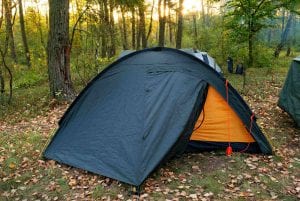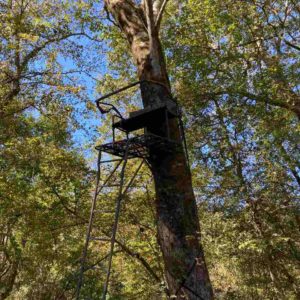
In an industry that’s always chasing the next big thing, down sleeping bags have been around for at least a century. And that’s partly because human ingenuity just hasn’t managed to develop a better insulator for the mass market.
Down is an extraordinary product — the result of tens of millions of years of evolution. It’s the super-fine fluffy insulation that sits underneath a bird’s feathers, engineered by nature to give warmth without adding weight.
This characteristic makes it ideal for outdoor gear — especially jackets and sleeping bags.
Best Cold Weather Down Sleeping Bag
Down sleeping bags really excel in cold weather conditions. There’s nothing quite so snug as being able to crawl into your bag in the middle of winter and being roasty, toasty warm.
The trouble is, sleeping bag jargon can be quite confusing, and gear manufacturers have a tendency to over-sell their products. Terms like “warm” get bandied about without much context, and what on earth do “comfort rating” and “lower limit” mean?
Even if you know you’re in the market for a 0-degree bag, you’ve still got to negotiate all the other variables of weight, compactness, price and quality.
To help you out, we’ve made a six of the best 0 degree bags for winter camping, from high-end backpacking models to value picks including:
- Sierra Designs Nitro 0 – arguably the best because of the awesome weight to price to warmth ratio
- Mountain Hardware Phantom 0 – seriously lightweight for a 0 degree down bag
- Kelty Cosmic 0 – super warm and insanely cheap for a down winter bag, but heavy and bulky
Read our full article “Best 0 Degree Down Sleeping Bags” here >>
Best Ultralight Down Sleeping Bags
It’s a bit of a challenge to identify the best ultralight down bag because it really depends on what you need it for. We’ve made a list of the lightest down sleeping bags on the market if weight is your sole consideration (in other words, you’re not too bothered about comfort rating, price, size or shape).
However, if you want to take into a range of features then check out this list of the best ultralight down sleeping bags:
- Thermarest Hyperion 20
- Mountain Hardwear Phantom 15
- Sierra Designs Nitro 20
- Sea to Summit Spark 5
Read our full article “Lightest Down Sleeping Bags” here >>
Best Value Down Sleeping Bags
One of the “down” sides (hoho) to down sleeping bags is they tend to be quite expensive. Even more budget down bags can come with a price tag that is fairly eye-watering when compared to a synthetic alternative.
Cheap down sleeping bags can also come with ethical considerations, with the “Responsible Down Sourced (RDS)” certificate noticeably absent from many of the budget listings you can find on places like Amazon.
But bargains can be found! Usually this comes at the expense of temperature rating or weight. This is because cheaper down bags will use a lower quality of down which in turn requires a greater volume of down to achieve increased comfort ratings.
For example, usually you’d be looking at 550-650 fill power for a budget down bag. But Sierra Designs Nitro 35 is an 800 fill power bag that can usually be found for less than $300. With a comfort rating of 27F, it has a brilliant ratio of weight to price for a 2-3 season bag.
Other brilliant buys include any of the Kelty Cosmic Down series for the tightest of budgets or the Mountain Hardware Bishop Pass series for anyone willing to spend a few extra dollars.
Read our full article “Best Budget Down Sleeping Bags” here >>
How To Choose the Best Down Sleeping Bag
A down-sleeping bag is a big-ticket purchase, so before you pull the trigger, it’s worth doing your research to make sure you’re buying the best bag for your needs.
- The most crucial factor in a sleeping bag is warmth. It’s useful to understand how the suggested temperature ranges for a sleeping bag are assessed, and how you might fit into those bands.
- For many outdoorsy types, weight will also be a big consideration. “Fill power” will give you an idea of the sleeping bag’s warmth-to-weight ratio.
- Sleeping bags come in different shapes and sizes. The “mummy” shape is the classic backpacker bag, but it’s important to make sure you get the right length.
- Over the years, gear manufacturers have refined the features of down sleeping bags with different baffle systems, hydrophobic down, and other developments.
Temperature
The single most important characteristic in a sleeping bag is whether it can keep you warm and comfortable at night. Fortunately, manufacturers provide plenty of information about this — so long as you know how to interpret it.
When you’re buying a down sleeping bag, you’ll want to consider where and when you’ll be using it, the temperatures you might encounter, and how resistant you are to the cold.
Are You a Warm or Cold Sleeper?
We all feel the cold differently when we’re sleeping outdoors. Some of us might be larger or smaller, while others might just be more used to cold temperatures. In general, women tend to feel the cold more than men, but there are plenty of exceptions to this.
The key is having some idea of where you sit on the scale. Are you the sort of person who’s out in a T-shirt in all weather, or do you need a lap blanket even when you’ve got the heating set at 75 degrees?
Knowing whether you sleep warmer or colder than average will help you interpret the temperature ranges on sleeping bags for your needs.
Season Ratings
Season ratings are the crudest tool for measuring the warmth of sleeping bags. While they can be very arbitrary and occasionally misleading, they’re still useful for getting you in the right ballpark.
Broadly, sleeping bags fall into three categories:
- Summer bags — Designed for camping in warm weather or sleeping indoors.
- Three-season bags — Theoretically designed for spring through fall.
- Winter bags — Heavier bags built for lower temperatures.
The problem, of course, is that winter on the Kamchatka Peninsula and winter in the Florida Keys are two very different things. In some places, snow still falls in late springtime, while in others the summer is so unbearably hot that even a light down sleeping bag would be too much. You see the difficulty.
Temperature Ratings
A much better way to judge the warmth of a sleeping bag before you buy it is to look at its EN/ISO temperature ratings.
The EN 13537 Standard was introduced in 2005 as a standardized test to help people compare sleeping bags. Since 2017, EN ratings have been replaced by ISO ratings — but the change was more to do with how the tests are carried out, so the two ratings are comparable.
Essentially, the testing process involves sticking a heated dummy covered in sensors in the bag. They then start lowering the room temperature, and take measurements to determine how and when the dummy cools down.
This is translated into three temperature ranges:
- The “comfort” range is normally interpreted as the temperature band in which a female camper would be comfy and warm (remember that women tend to sleep colder than men).
- The “transition” range is the temperature band in which a warmer sleeper would start to feel cold. The lowest figure in this range is known as the “limit.”
- The “risk” range is the temperature band in which the sleeping bag would probably keep you alive but not happy. Even warm sleepers will struggle in this range, and the lower you go, the greater the risk of hypothermia.
So you can see why you absolutely shouldn’t plan on dropping into the risk range when you’re buying a sleeping bag.
Really, it’s the comfort range you should be looking at — possibly venturing into the transition range if you’re a warm sleeper or if you’re prepared to endure a miserable night (as gram-counting trail runners sometimes are).
Of course, there are a million and one things that can mess with those ranges.
Even a warm sleeper will find it harder to stay comfortable if they’re worn out, cold, dehydrated, or underfed when they go to bed — and the reality of backpacking trips is that you may well be all those things at some point.
Your sleeping pad and the clothes you wear can make a big difference, as can the weather conditions.
With that in mind, it’s always best to buy a sleeping bag that’s a bit warmer than you think you’ll need — on the principle that it’s easier to vent a bit of heat than it is to build it up.
Weight
Apart from warmth, the other main factor for backpackers will be weight — since no-one likes ponying around a heavier load than they have to.
All things being equal, you’d think a warmer bag would be heavier, but that goes out of the window when you bring fill power into the equation.
Understanding Fill Power
The important thing to note about fill power is that it doesn’t tell you how warm the sleeping bag is.
In fact, fill power measures the warmth-to-weight ratio of the down filling.
The miracle quality of down is its ability to puff up (or “loft”) when you take the sleeping bag out of its stuff sack.
The down filaments trap tiny pockets of hot air, which keeps you toasty warm. Higher-grade down has better lofting performance, and will fill a larger space — providing the same amount of insulation for a smaller weight of down.
This is what fill power measures. It tells you how many cubic inches a single ounce of down will expand to fill. For example, one ounce of 700 fill-power down will take up 700 cubic inches of space.
The warmth of the bag still depends on how much insulation you use, but a higher fill-power down will give you the same amount of warmth for less weight.
Duck or Goose Down?
Duck down is cheaper than goose down — in some cases by half the price — and, compared to lower fill power (i.e. lower quality) goose down, you won’t notice much of a difference.
The key difference is that duck down just can’t achieve the fill power of high quality goose down, so if you want the best warmth-to-weight ratio, you’ll need to pay for goose. And you really will pay for it, because the top-grade stuff is mighty expensive.
Down Sleeping Bag Shapes
The shape and size of a down sleeping bag are often overlooked, but these factors can make a big difference to warmth and comfort. In general, there are two types of sleeping bag.
Rectangular
Best for car camping or situations where you won’t have to carry your stuff very far, a rectangular sleeping bag gives you plenty of space to move around.
However, it’s not very efficient in terms of warmth for weight, so you won’t really see rectangular bags aimed at backpackers.
In fact, rectangular bags are also more often filled with synthetic material, since weight is less of an issue.
Mummy
The mummy-shaped bag cuts right down on wasted space, making it lighter and less bulky. Because it’s fitted to the human form, it also warms you more efficiently.
There’s a reason the mummy is the go-to design for backpacker bags, but it does take a bit of getting used to and can feel restrictive if you haven’t slept in one before.
It’s worth pointing out that different manufacturers — and even different designs by the same company — may offer different fits. Some mummy-style designs can be comparatively roomy, while those aimed at ultra-lighters will usually be more towards the straitjacket end of the scale.
Double
If you always go camping with your significant other, you might consider a double sleeping bag. These can be really cozy — since they allow you to share body heat — but they can be difficult to keep warm in if you’re on your own.
A more flexible option is to go for two bags from the same manufacturer that are designed to zip together. That way you get all the perks of the double bag, but you can also fly solo if you want to.
Sizing
You may not even be aware that sleeping bags come in different lengths — but they do, and there are a couple of reasons why getting the wrong size is bad news:
- If your sleeping bag is too short, not only will you be uncomfortable, but you may end up crushing the insulation in the hood and foot box, creating cold spots.
- If your sleeping bag is too big, you’ll be expending more energy heating the unused space.
Sleeping bags usually come in “small” (up to 5’6”), “regular” (up to 6’) and “long” (up to 6’6”) lengths, but this can vary across manufacturers so it’s always best to check.
Since most of us are between those sizes, which one you pick may depend on what you’re willing to compromise on. For example, someone who’s 6’2” might decide they’d prefer a bag with a slightly tighter fit rather than one that’s heavier and more difficult to heat.
Men’s Bags vs Women’s Bags
In case you hadn’t noticed, men and women have quite different shapes — and since efficient sleeping bag design is based on tailoring the bag to fit the form, there are often differences in fit.
Bags for women will tend to be a bit roomier across the hips and narrower across the shoulders, while men’s will be the reverse.
Remember too that the temperature ratings brands give their bags may vary for women’s and men’s models, so the same bag may be classed as less warm for women than men. To avoid confusion, it’s always best to drill down into the temperature ranges.
Other Features of Down Sleeping Bags
Sleeping bag design is always evolving, and manufacturers have developed all kinds of new features and treatments to make down bags more comfortable and durable.
Water-Resistance and Hydrophobic Down
The biggest problem with down is that it doesn’t mix well with water. Get it wet and not only does it lose most of its insulating properties, but it also takes ages to dry.
Gear manufacturers can mitigate this in two ways. In many cases, they’ll coat the shell fabric of the sleeping bag with some sort of water-repellent substance, but sometimes they will also treat the down itself.
Different manufacturers use different products, but some of them are really good — for example, Therm-a-Rest claims that the Nikwax Hydrophobic Down they use in their bags absorbs 70% less moisture and dries three times faster than the untreated equivalent.
Of course, hydrophobic down will bump up the cost of your bag — and it still won’t survive a soaking — but if you’re heading out for a long back-country trip in spicy conditions then it might well be worth it.
Baffles
Baffles are the lines of stitching that hold the down filling in place. They’re usually either horizontal or vertical.
- Vertical baffles are often thought to be better for more fitted designs of sleeping bags, but they need layers of mesh to hold the filling in place so they can be a bit heavier.
- Horizontal baffles are more common, and they have the added bonus that you can shake the down around inside the bag to redistribute it. For example, if you’ve got a really good sleeping pad then you won’t need as much insulation underneath, so you could bulk up the insulation on top of you instead.
Draft Excluders
For warmer bags, you’ll want to check that there’s an insulated draft excluder around your neck, and another one along the inside of the zip.
Make sure that the latter of these isn’t likely to get snagged, since there’s nothing quite like fumbling around in a dark and confined space trying to free a stuck zip in the middle of the night.
Hoods
While rectangular bags for car camping often don’t come with hoods, backpacker bags pretty much always do — and they’re absolutely essential for winter camping.
Look to see if the hood can be cinched in when it’s really cold, and have a think about whether it’s easy to do this from inside the bag.
Warranties and Repairs
Most manufacturers will offer a warranty on manufacturing defects, and in some cases a lifetime guarantee.
Probably more important, though, is access to some sort of specialist repair service.
If you look after them, down bags can lead long and adventurous lives, and they may also well need repairing, refilling or specialist cleaning at some point. Some manufacturers will have their own repair shops, while there are also independent companies who can do the job.
Ethics
Over the last decade, we’ve all become increasingly aware of the ugly side of down production.
While down is nominally a by-product of the meat industry, several investigations in 2010–2012 uncovered that inhumane practices like live-plucking were widespread.
Some down has also been connected to foie gras production, which involves a form of force-feeding so cruel that the delicacy is banned in several countries and states.
To its credit, the outdoor industry responded to these revelations by implementing rigorous assessment standards for down producers.
The best-known is the Responsible Down Standard (RDS), but some manufacturers operate their own separate schemes (until recently, Patagonia famously used its own Traceable Down Standard, though it has now joined the RDS).
All the same, down production is a bit like the tea and chocolate industries, in that having the standards there is only half the battle. The real challenge is inspection and enforcement — which can be difficult for US companies when most of their down comes from China and Eastern Europe.
Sadly, animal rights organizations occasionally carry out covert investigations that reveal flagrant violations of the Responsible Down Standard, and while there is genuine will for change in the outdoor industry, manufacturers must feel like they’re playing an endless game of Whack-a-Mole.
As a customer, you can help by making sure that any down bag you buy conforms with the Responsible Down Standard, and perhaps by looking for gear manufacturers who commit to even higher welfare standards.
FAQs
What is a Down Sleeping Bag?
A down sleeping bag is a sleeping bag filled (insulated) with the down feathers from ducks or geese. This is different from a synthetic sleeping bag which uses polyester fibers for insulation. Both types of insulation have pros and cons, more of which you can read about here.
Are Down Sleeping Bags the Best?
Many people will swear that down sleeping bags are the best. However, there are times when a synthetic bag is better. Down sleeping bags have much better warmth to weight ratios. But synthetic bags manage better if they get wet (although down treatment tech is improving all the time).
How Do I Choose the Right Down Sleeping Bag?
Choosing the right sleeping bag is usually about weighing up various factors — mainly warmth, weight, shape, and cost. Read our full guide to help you choose the right down sleeping bag…
Should I Get a 15 or 30 Degree Down Sleeping Bag?
In general, it’s better to get a bag that’s slightly warmer than you think you’ll need. It’s usually easier to vent a bit of heat than it is to sleep comfortably in a bag that’s not warm enough.
How Do I Know What Temperature Down Sleeping Bag to Get?
You’ll need to think about the lowest and highest temperatures you might encounter while using the sleeping bag, and consider whether you think you’re a warm or cold sleeper. You can then compare these factors to the manufacturer’s recommended temperature ranges.





